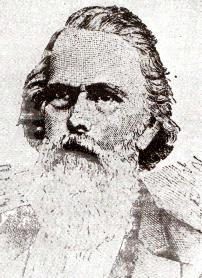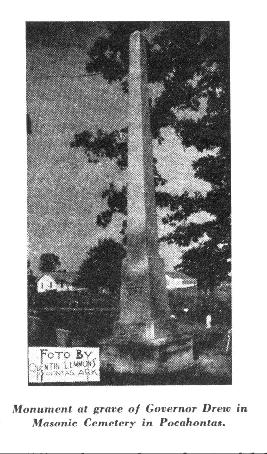
Hood County Texas Genealogical Society
THOMAS STEPHENSON DREW
1802 - 1879
FROM HISTORY OF RANDOLPH COUNTY, ARKANSAS
by Lawrence Dalton, Published 1946 - 1947

|
Thomas Stephenson Drew |
Thomas Stephenson Drew, the fourth Governor of the state of Arkansas, was a resident of Randolph County. He is the only governor the county has had. He was born near Lebanon, Wilson County, Tennessee, August 25, 1802. He was the son of Newton Drew who came to Tennessee from Southampton County, Virginia, in 1797.
Governor Drew first settled in Arkansas in Clark County in 1821. Here he served one term as county clerk, but did not ask-for a second term. This was in 1823 to 1825.
After leaving the office of clerk of Clark County he embarked upon the business of an itinerant peddler. While doing this he made trips all over Arkansas Territory. While on one of these trips, which he made on horseback, he visited Pocahontas, which was then a small trading post and owned by Ransom Sutherland Bettis. Here he met Bettis' daughter, Cinderella, and they were married. The Bettis family was one of the first families of Randolph County, coming here from North Carolina.
After Thomas Drew married Cinderella Bettis her father gave her as her dowry eight hundred acres of land in Cherokee Bay. Here he and his bride moved and made their home for several years. He was elected to the office of county judge of Lawrence County, and served from 1832 to 1835, while residing at his plantation home, which was on the site of the present town of Biggers. The county seat of Lawrence County was at Old Jackson at that time.
The Territorial Legislature of 1835 cut off Randolph County from Lawrence County in October of that year. In 1836 a Constitutional Convention was called to meet in Little Rock, in January, to draw up a state constitution. Thomas S. Drew and Henry Slavens, both of Cherokee Bay in Randolph County, were chosen as two of the delegates from Lawrence and Randolph counties. Thus Thomas Drew helped write our first state constitution.
After this Drew lived the life of a planter on his farm and was not identified with public life until 1844 when the state Democratic Convention nominated him for Governor. He was elected by a large majority over the Whig candidate. He served this term, which was for four years at that time, and did not announce for a second term. Nevertheless, he was elected for a second term without opposition in the state. A few days after the election, On November 10, 1848, Drew surprised his friends and constituents by announcing that he would not serve a second term.
While still in office, he appeared within the Senate chamber and read a letter announcing that he was resigning the office. The letter, in part, is as follows: "The overwhelming desire of friends, who believed they could do much, and no doubt intended to move in the matter, pledged me that every exertion would be made to raise my salary before the second term began, to a point sufficient at least to pay my expenses with my family at the seat of government, which the constitution of the state makes it imperative that the Executive shall reside. The failure to do this, or any attempt by those who had previously manifested so much interest in regard to this subject, placed me at once where I found that the time had elapsed in which it was possible to effect anything of the kind for my relief, under the prohibitions of the Constitution. The ceremonies of the inauguration were but just over when the determination was taken to resign, which I now do so, from the office of Governor of the State of Arkansas." So thus, only a few days over a month of his second term gone, Thomas Drew quit the office of Governor of Arkansas because the salary at that time was insufficient to "at least pay the expenses of the family" of the Chief Executive of the state.
Richard C. Byrd became acting Governor.
Being governor was not all the noteworthy things which Thomas S. Drew did during his lifetime. Besides being also county clerk of Clark County, county judge of Lawrence County and a member of the 1856 constitutional Convention.
He also has the distinction of being one of the founders of the city of Pocahontas. He and his father-in-law, Bettis, owned the land where the town is now located. As is recorded in another chapter of this book, Drew donated several parcels of land to the town. He also appeared in court at the 1837 term and acknowledged the execution of a bond to the county treasurer in the amount of $3,000.00, which was a donation toward the building of a courthouse for Randolph County, "provided the building was located in Pocahontas." Bettis did likewise in the amount of one thousand dollars. March 17, 1841, Drew recorded in the deed record of Randolph County his "Drew's Addition" to the town of Pocahontas.
Just when the Drew family left the plantation home in Cherokee Bay is not known. It is supposed that they moved away when he was elected Governor. It appears that during the years that he was in Little Rock that he suffered severe financial losses. The records show that Drew and his wife "deeded" considerable real estate and several slaves to his mother-in-law, Mary Bettis, on June 1, 1850, "For money borrowed April 1, 1846, in the amount of $4,100.00." Mrs. Bettis lived in Desha County, Arkansas, at that time. Ransom S. Bettis died about 1841 or early 1842. Drew was appointed as his administrator April 13, 1842.
Mrs. Drew's mother died at Lake Providence, Louisiana, June 23, 1852. Mrs. Drew inherited considerable property from her mother at that time. But it seems that the family had become so deeply in debt that they never recovered from the effects.
On October 23, 1849, a large assembly of men from many states of the Union met at Memphis for the first meeting of the proposed Memphis Railroad. This was a proposed railroad from San Diego, California, on the Pacific coast to end at Memphis. Thomas S. Drew was the representative from Arkansas, being one of the vice-presidents elected at the convention. Others from Arkansas were in attendance.
April 7, 1853, Thomas S. Drew was appointed by the President of the United States to the office of superintendent of Indian affairs for the Southern Division, with an office at Van Buren. He was not an applicant for the place. No record can be found where he ever took over the office. It is doubtful that he did, since the local records show various activities of his in Randolph County all along during this period.
In the election of 1858, Drew was a candidate for Congress from the Second Congressional District on the Independent ticket. Albert Rust was the Democratic candidate. Rust won the election by a large majority. Just why Drew ran as an Independent is not known. It is possible that he had lost his popularity and failed to be chosen as the regular democratic candidate and ran as an Independent, hoping to gain his former support.
One noteworthy act of Governor Drew while in that office was his proclamation which set aside Thursday, December 9, 1847, as a day of Thanksgiving. This was the first Thanksgiving ever observed in Arkansas. Although the day had been observed in New England for many years, it had not been generally observed in the South prior to this time.
After 1858 Drew seems to have ceased to take a very active part in public affairs. His name is mentioned locally during this period, mostly by deed records, where he and his wife disposed of some of their holdings. He was employed in the general store of Green R. Jones in Pocahontas as bookkeeper at a salary of $200 per month in 1866. Soon after this he resigned and opened an office as attorney. He is said to have had a very good legal mind. A portion of this salary as bookkeeper was credited to Drew's account at the Jones store. He seems to have been badly in debt at this time. When William H. Jarrett came to Pocahontas from Columbia in 1866, he also got a job in Jones' store. After Drew resigned, Jones and Drew made an agreement that Jarrett was to board with the Drew family for a price of twenty-five dollars per month, this amount to be taken off Jarrett's salary and applied on Drew's account at the store. Jarrett remained with the family four years.
Thomas S. Drew and Cinderella Bettis Drew had five children living at that time. Their names were Joe, James and Ransom, boys, and Emma and Sadie, the girls. The girls both married Federal officers, although the family was sympathetic toward the cause of the Confederacy. Evidently this did not meet the approval of the neighbors who were bitter toward the North. A letter written at the time of the marriage of Emma to the northern army officer from some young lady residing in Pocahontas to a friend elsewhere stated: "You asked about Emma Drew's marriage to the Yankee; well, that is about all you could expect of her," was the belittling reply. We understand that this letter is in the possession of Mrs. H. M. Jacoway of Little Rock at this time.
Both the Drew girls were musicians.
Nothing is known of the Drew family after 1870. Some writers have stated that they moved to Texas "soon after the close of the war." This is incorrect, as shown above. It is likely that they did remove to that state about 1871 or 1872. Thomas Drew died there at Lipan, Hood County, Texas, in 1879. Here his remains lay in an unmarked grave until 1923, when a number of interested Randolph County citizens asked W. A. Jackson, who was state senator from this district at that time, to ask the Legislature to appropriate one thousand dollars to be used to move the remains of Governor Drew from Texas for re-interment in the Masonic cemetery in Pocahontas.
This was done and a committee composed of Senator Jackson, R. N. Hamil and Judge J. W. Meeks was appointed to go to Texas for this purpose. The ashes of Arkansas' third governor was deposited with fitting ceremonies in the cemetery named above on Decoration day, May 30, 1923. One of the largest crowds ever assembled in Pocahontas up to that time attended the ceremony.
Thus comes to a close the story of Randolph County's only citizen who up to the present has occupied the office of Governor of Arkansas.

|
Monument at grave of Governor Drew in Masonic Cemetery in Pocahontas, Randolph County, Arkansas |
An appropriate marble shaft stands on the spot of the last resting place of this noted man, who was not only a governor of a great state, but one of the first citizens of Cherokee Bay, one of the first county officials of Lawrence and Clark counties, one of the founders of the city of Pocahontas, and the only man who ever resigned as governor of the state because the salary was too low to support his family.
Quoting the words of the late William Jarrett who, as stated above, lived in the Drew home four years, "Thomas Drew was small in stature, had a kindly, friendly smile, and was one of the gentlest, most patient men you ever saw."
~ Web Page by Virginia Hale ~